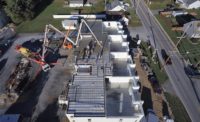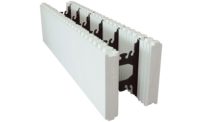Without question, the building and construction industry has been impacted by the COVID-19 outbreak. Approximately 1.1 million construction jobs were eliminated in the first two months of the pandemic prior to the industry’s designation as “essential.” While the industry has recouped nearly 80 percent of its workforce since then, companies will need to hire another 1 million workers over the next two years to meet the country’s insatiable demand for new home construction and improvement.1
That said, the pandemic is only exacerbating the skilled labor shortage. Young laborers fresh out of trade school or an apprenticeship are now few and far between. That, plus an aging construction workforce (the average age is 43), has created a serious gap in employment.
Meet Industry Challenges With Free Training and Professional Development Programs
To mitigate the labor shortage and capitalize on the heightened demand for construction, building and construction companies must carefully evaluate ways to retain the current workforce. One solution is to employ meaningful training and professional development programs. A necessary and beneficial investment, such opportunities will help employees feel more confident in their job performance, demonstrate increased productivity in the field and remain more committed to their company.²
The benefits of skills-based training also extend to the construction companies themselves, including a more sustainable labor pool, improved jobsite proficiencies and increased professionalism across the industry. While advantageous, the unfortunate reality is access to a skills-based training course or a certification program with no cost to companies or their workers is hard to come by. This is where trade associations like the Structural Insulated Panel Association (SIPA), which are committed to the sustainable advancement of the construction industry, come into play.
SIPA Aims to Empower Building and Construction Professionals With Improved Skills-Based Training Course
Since 1990, SIPA has provided a forum for education, quality assurance and technical research to advance construction practices and combat industry-wide challenges. Recognizing the need to retain the construction workforce, SIPA is among the trade associations now offering accessible training programs to increase the adoption of progressive building envelope construction practices that save time and labor to provide healthy, low embodied carbon structures. This includes the new skills-based program Building Education with SIPs Training (BEST).
The free 10-part training program equips builders with the foundational principles of building with structural insulated panels (SIPS): high-performance building panels used in floors, walls and roofs. Because SIPs are ready to install when they arrive on the jobsite and can go up more quickly than traditionally framed buildings, they provide time, material and labor cost-savings to meet pressing challenges posed by the industry’s labor shortage. Now, perhaps more than ever, it’s important for professionals to turn to efficient building solutions that maximize jobsite operating efficiencies.
At this point, you may be asking yourself: What are SIPs? Structural insulated panels, or SIPs, are structurally self-sufficient, high-performance building panels used in walls, roofs and floors for residential and light commercial construction projects. The panels are made by sandwiching a core of rigid foam insulation between two structural facings, such as oriented strand board (OSB). SIPs are manufactured under factory-controlled conditions and can be tailored to accommodate unique project specifications. The result is a nearly airtight building system that is incredibly strong, energy-efficient and cost-effective.
Upon completion of BEST, program-goers will be well-versed in advanced SIP construction, having covered key topics such as:
Best SIP Design Practices and Engineering Principles
SIP builders often work closely with the project architect, SIP designer and SIP manufacturer during the initial design phase to arrive at a finalized set of panel layout drawings. Because the SIP installation process relies heavily on the accuracy of these drawings, it’s important for builders to understand the basic design and engineering principles of SIP construction. Armed with a high-level understanding of these principles, builders can identify design errors or potential constructability issues during the design phase to keep a project on budget and on pace for timely completion.
SIP Estimating and Ordering Process
Although most panel providers offer quoting services, builders may be asked to conduct estimating in-house. Building with SIPs—or any other prefabricated building system—requires more attention to detail during the design phase, and accurately quoting the project can impact the project’s bottom line. The BEST program identifies critical factors that can impact the estimation, including the finalized SIP layout drawing, the structure’s HVAC equipment and the level of fabrication offered by the SIP provider. Being knowledgeable of these factors can help novice and experienced SIP builders alike generate an accurate estimate to ensure the project is completed on budget.
Jobsite Organization and Panel Preparation
While SIP structures are known for going up faster than traditional wood framed structures, BEST encourages builders to maximize efficiencies through jobsite organization and panel preparation. For example, when working with SIP roofs, builders should do as much work as possible on the ground, including pre-drilling panel screws, installing splines or blocking, and pre-assembling sections of panels. This approach saves time, supports jobsite safety and minimizes equipment rental time. It is just one of the many SIP construction best practices covered within the free course.
Overcoming Objections to Using SIPs
A home built with SIPs will deliver energy-savings, improved indoor air quality (IAQ) and long-term durability. That said, SIP construction is a relatively new building practice, and consequently many homeowners, general contractors and architects are unfamiliar with it. This unfamiliarity can lead to a number of objections, including price, fire resistance and ease of modification. By becoming aware of these common objections and preparing digestible responses, builders can help their customers move into the future of home construction.
Attract and Retain Employees With Accessible Resources and Equal Opportunity for Professional Growth
After mastering each component of the 10-part series, BEST “graduates” will be dubbed a Registered SIP Builder by SIPA and will join the ranks of builders who are embracing advanced building envelope construction. Builders can reach the next level and become a Registered Master Builder by submitting a successfully assembled SIP home with an air leakage blower-door test result as proof of their correctly applied knowledge.
Program graduates may also apply their new designation towards an Insulation Professional certification, an accreditation given to industry professionals with a strong understanding of air sealing, walls, floors, attics and building science. To provide the same opportunity to underprivileged adults and to help close the employment gap, the new SIPA Diversity Equity Inclusion component states that BEST courses are Job Corp program certified with the U.S. Department of Labor. Job Corps was established over 50 years ago to help young people ages 16 through 24 finish their education, acquire career technical skills and gain employment. With the Insulation Professional certification within reach, these young adults can set their professional career path on a positive trajectory.
Beyond establishing credibility, programs like BEST are critical to attracting new workers and retaining current employees—ensuring the construction industry can keep pace with increased demand. Such programs also help to close the enormous gap of female under-representation in the construction sector.
Looking Ahead
As more in the field will recognize, forward-thinking building methods like SIPs will play a key role in meeting demand for new home construction and improvement. After all, with retirement beckoning many in the current workforce, the labor shortage is only going to worsen. Building and construction companies will have to look for new ways to retain valuable employees in the competitive labor pool. Free training programs like BEST are the industry’s best bet for meeting this critical moment.
¹ See “The war for talent: how contractors battle for workers” at www.constructiondive.com.
² See “Contractors should view training as an investment in success” at https://www.forconstructionpros.com.








Report Abusive Comment